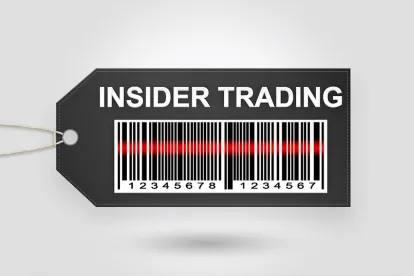On February 23, the U.S. Court of Appeals for the Fourth Circuit reversed a mid-trial grant of judgment as a matter of law against the Securities and Exchange Commission in a jury trial for insider trading. The decision in SEC v. Clark is a reminder that the SEC can meet its burden of proof by presenting merely circumstantial, rather than direct, evidence of insider trading and that a trial court must not weigh evidence, determine witnesses’ credibility, or substitute its judgment for the jury’s in deciding whether to grant a motion for judgment as a matter of law.
Background
The Clark appeal ensued from what some viewed as a surprising decision when a federal court in Virginia granted judgment as a matter of law for the defendant in an SEC enforcement action after the SEC had presented its case in chief to the jury and before the defendant had put on his case. The defendant allegedly had traded on material nonpublic information (“MNPI”) from his brother-in-law about a merger involving the company where the brother-in-law worked as Corporate Controller. The SEC relied on what it deemed suspicious trading: the defendant had bought speculative out-of-the-money call options on the company’s stock; the transactions had been unusual for the defendant; the defendant had borrowed money to pay for some of his trades; and he allegedly had told his son to buy some of the same options. The brother-in-law settled with the SEC and paid $240,000, but the defendant proceeded to trial.
The court dismissed the action after the close of the SEC’s case, finding no testimony, documents, or other evidence showing that, despite the defendant’s seemingly anomalous trading pattern, the brother-in-law had obtained MNPI about the proposed merger and had passed it to the defendant. The court concluded that there was “‘no circumstantial evidence here that gives rise to an inference that [the defendant] received the insider information.” The SEC appealed, and the Fourth Circuit reversed and remanded for further proceedings.
Fourth Circuit’s Decision
The Fourth Circuit framed its ruling by stressing the standard for a motion for judgment as a matter of law under Fed. R. Civ. P. 50(a). Judgment is appropriate only when “‘a party has been fully heard . . . and the court finds that a reasonable jury would not have a legally sufficient evidentiary basis to find for the party.’” The nonmovant “must present more than a scintilla of evidence” to defeat a Rule 50(a) motion, but the court “must not weigh evidence, determine witness credibility, or substitute [its] judgment of the facts for that of the jury.”
Applying that standard, the Fourth Circuit held that the trial court had “failed to consider the evidence in the light most favorable to” the nonmoving party (the SEC) and had improperly taken the case from the jury. The evidence could have enabled a reasonable jury to conclude that the defendant’s brother-in-law had learned about the potential merger before the defendant began trading the issuer’s call options. For example:
-
The brother-in-law had communicated with the company’s Chief Accounting Officer – a close personal friend, with whom he was in constant contact – about the potential impact of a transaction like a merger on the company’s unvested stock, which both of them had. The pair had exchanged those emails just one day after the company’s Board had responded to the prospective buyer’s initial merger offer.
-
When the proposed merger price had reached a level acceptable to the company, the brother-in-law began emailing employment recruiters, and he later told recruiters that he had been working on the merger the day before the defendant began to trade.
-
The Chief Accounting Officer testified that he had known about the merger negotiations before the defendant began trading.
The court also found sufficient evidence for a reasonable jury to conclude that the brother-in-law had conveyed MNPI about the merger to the defendant before the defendant began trading. For example:
-
The defendant started trading on the very day that the company accepted the buyer’s merger offer.
-
Until that trade, the defendant had not traded the company’s call options except on one occasion, nearly a decade earlier. The defendant had actively traded the company’s put options, all of which had expired the month following the release of the company’s quarterly financial reports. The trial court viewed those trades as evidence that the defendant had a history of speculating in call/put-type transactions. But the Fourth Circuit observed that “[a]nother way [of viewing those trades] is that the evidence shows an opportunity and pattern of trading [company securities] with inside information from [the brother-in-law].”
-
The defendant had taken “extraordinary measures to buy the call options”: he had “emptied his wife’s retirement account, borrowed money at a 9% interest rate, and [taken] out a loan on his car” to fund the purchases.
-
The defendant had advised his son to make similar purchases and had later “lied to the FBI about whether he had done so.”
-
The trades had proven “remarkably lucrative,” yielding a return of more than 70% in a short period of time.
The Fourth Circuit noted that, despite this evidence, a jury could reasonably decide that the brother-in-law had not had any MNPI when the defendant began trading. But the court emphasized that, in reviewing a grant of judgment as a matter of law, “our task is only to decide whether there is evidence from which a reasonable jury could have decided that [the defendant] was liable.”
Implications
The Clark decision is obviously fact-bound, and it does not make new law on insider trading or on motions for judgment as a matter of law. But it does illustrate that trial courts must not take too narrow or rigid a view of circumstantial evidence and its sufficiency to prove a case. As the court observed: “because a defendant or interested party rarely makes a statement or reveals information that amounts to direct evidence of impermissible trading based on confidential insider information, the Commission may present circumstantial evidence to meet its burden of proof.” The court noted that “[c]ircumstantial evidence, if it meets all the other criteria of admissibility, is not only sufficient, but may also be more certain, satisfying and persuasive than direct evidence.”
This endorsement of circumstantial evidence is consistent with other decisions, such as the Fifth Circuit’s ruling last year in SEC v. World Tree Financial, L.L.C. World Tree was not an insider-trading case; it involved allegations of “cherry-picking” against investment advisers, who allegedly had traded for clients in a block trade or omnibus account and then allocated the transactions to favored clients (or to themselves) depending on the end-of-day results. The SEC’s case was based on statistical evidence: the SEC’s expert testified that the investment adviser had transmitted most trades to the broker during the trading day, but, 90% of the time, had waited until after the markets had closed to allocate the trades. The expert’s account of the trades and allocations showed a “‘once in one million chance that these patterns [of allocations] could have occurred if allocations were being made without regard to first-day returns.’” The court held a bench trial and ruled in favor of the SEC. The Fifth Circuit affirmed and rejected the defendants’ argument that the SEC was required to introduce direct evidence of cherry-picking instead of relying on statistical evidence.



 />i
/>i

